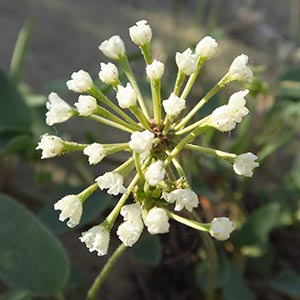Abronia mellifera
Abronia fragrans
honey scented sand-verbena, white sand-verbena
fragrant verbena, fragrant white sand-verbena, heart's-delight, snowball sand-verbena
decumbent to ascending, much branched, elongate, glabrous or glandular-pubescent.
procumbent to semierect, slightly to moderately branched, elongate, sometimes reddish at base and nodes, glandular-pubescent, viscid.
petiole 1–6 cm;
blade ovate to lance-elliptic, 1–6 × 0.5–4 cm, margins entire to sinuate and ± undulate, surfaces glabrous or glandular-pubescent.
petiole 0.5–8 cm;
blade ovate to triangular or lanceolate, 3–12 × 1–8 cm, margins entire to subsinuate and slightly undulate, adaxial surface glandular-pubescent, abaxial surface more densely and longer pubescent, or sometimes villous.
peduncle longer than subtending petiole;
bracts lanceolate to obovate, 5–12 × 1–5 mm, papery, glabrate to glandular-pubescent;
flowers 25–60.
peduncle longer than subtending petiole;
bracts linear-lanceolate to oval-ovate, 7–25 × 2–12 mm, scarious, glandular-puberulent to short villous;
flowers 30–80.
tube pale rose proximally to greenish distally, 15–25 mm, limb white, 7–12 mm diam.
tube greenish to reddish purple, 10–25 mm, limb white, (2–)6–10 mm diam.
winged, broadly obdeltate or cordate in profile, 6–10 × 4–10 mm, thin, usually coriaceous, rarely indurate, base attenuate, apex prominently beaked;
wings (2–)5 (when 2, folded to form single deep groove), without dilations, broad, thin, without cavities.
winged or not, fusiform and appearing deeply grooved when wingless, when wings not distorted, fruit ± cordate in profile, tapered at base, with prominent beak in broad notch at apex, 5–12 × 2.5–7 mm, indurate, rugose veined or, if wings distorted, fruit ± rhombic in profile and tapered at both ends, or obdeltate and truncate at apex, with prominent beak;
wings 4–5, thick, narrow, not dilated at apex, cavities extending throughout;
peripheral fruits often distorted, S-shaped in lateral view.


